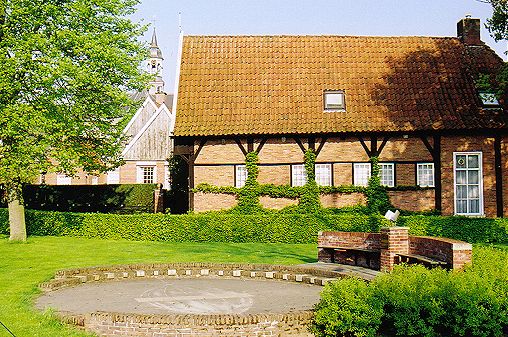
Analemmatic dials
Oostwal, Ootmarsum

Gnomonically speaking, this is the nicest and best equipped analemmatic dial I know. I discovered it by chance, when we tried to escape from Ootmarsum through a labyrinth of one-way streets. Suddenly, there it was, tucked away in a small public garden!
The smooth dial face is made of cement and enclosed in a two-leveled rim of bricks. The marble hour and half-hour points are inserted into the lower level. The major axis of the ellipse is 7.80 meter (26 ft).
A brick wall at the north side follows the curvature of the dial. Two benches mounted here invite the visitor to overlook the whole. The wall, together with the accessory equatorial dial on top (more on that in a minute) provides the whole with the 'sculptural presence' analemmatic dials are often lacking.
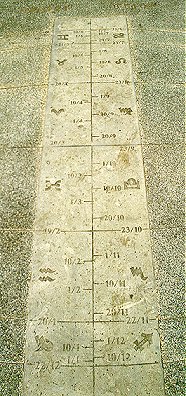 |
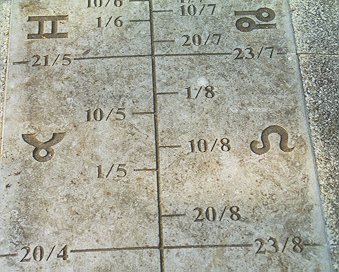 |
The date line has been engraved into a slab of stone. It is divided into the zodiacal months, and also into units of 1/3 calendar month.
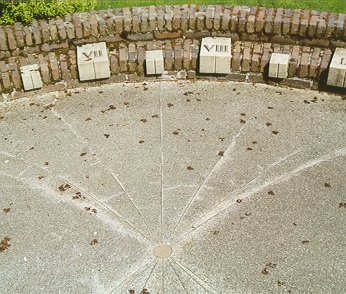
The foci of the ellipse have been marked by bronze points, as are a number of 'Lambert's circles'. These are circular arcs that pass through both foci and a point of the date line, in this case the beginning of the zodiacal months. They intersect with the edge of the ellipse at the times of sunrise and sunset on that particular date. This is the only large analemmatic dial I know in which a full set of Lambert's circles is installed. The analemmatic dial in Rijswijk (yes, also NL) only has the two outer Lambert circles, for the solstices.
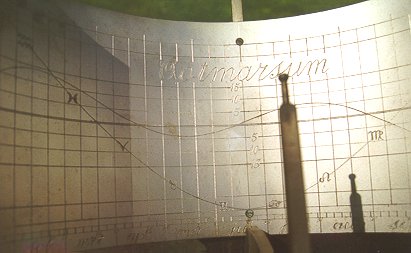
In order to use an analemmatic dial, you need to know the date, or you wouldn't be able to pick the right spot on the date line. In case you just forgot, no problem! There's a small equatorial nodal dial on top of the wall. It provides the date, using the declination of the sun. You only need to know whether the days are growing longer or are shortening. And at the date you can read the equation of time. Quite ingenious! A panel with instructions for use is mounted below it.
Finally the inscription "Tempus vitam regit" (The time reigns life) is laid into the floor in bronze letters. It is the motto of the antique clocks gallery 'De Oude Tijd'. Owner Bote Holman presented the dial to the city of Ootmarsum when he opened the gallery in 1989. It was inaugurated in 1993, in the presence of Queen Beatrix of the Netherlands.
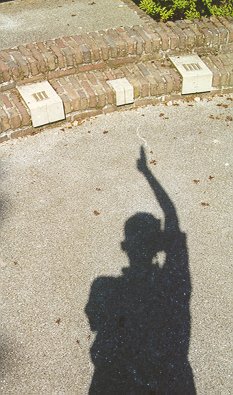 Bote Holman told me an amusing story about this. Some upheaval was made about an alleged blunder: the four o'clock point was not labeled IV, as it should, but IIII. When he asked the critics to have a look at their own clock at home, the commotion faded away: most clocks with Roman numerals show four o'clock this way! (See also the page on the four o'clock problem.)
Bote Holman told me an amusing story about this. Some upheaval was made about an alleged blunder: the four o'clock point was not labeled IV, as it should, but IIII. When he asked the critics to have a look at their own clock at home, the commotion faded away: most clocks with Roman numerals show four o'clock this way! (See also the page on the four o'clock problem.)
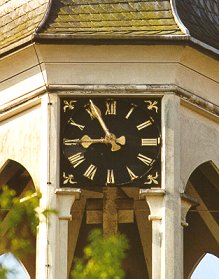
As an excuse for the Ootmarsum citizens it may be noted that the clock on top of their own church, in the center of the city, is the exception that proves the rule.
Location: 52.4° N, 6.9° E
Design: B.P.U. Holman
Inauguration: August 1993
Double vertical dial
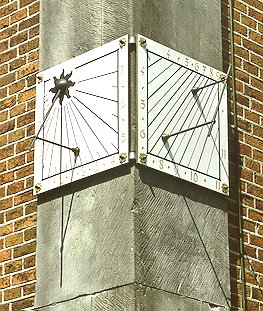 The historic city of Ootmarsum really is a gem. I just include here the double vertical dial which - again on the initiative of Bote Holman - recently returned to its former location on a corner of the Old City Hall.
The historic city of Ootmarsum really is a gem. I just include here the double vertical dial which - again on the initiative of Bote Holman - recently returned to its former location on a corner of the Old City Hall.
Location: 52.4° N, 6.9° E
Design: B.P.U. Holman
Inauguration: June 1995
Recently, the Chronomium, a center devoted to the measurement of time, interesting for all ages, opened in gallery 'De Oude Tijd'.
Nearby sundials at my website: